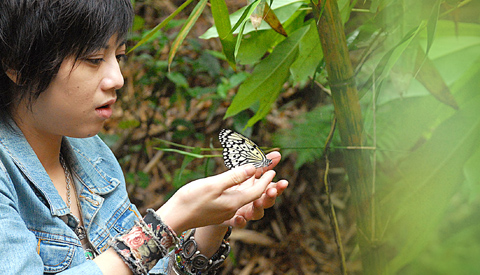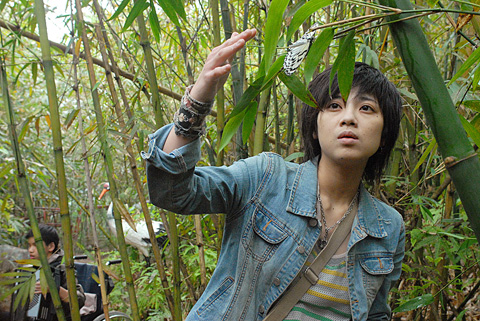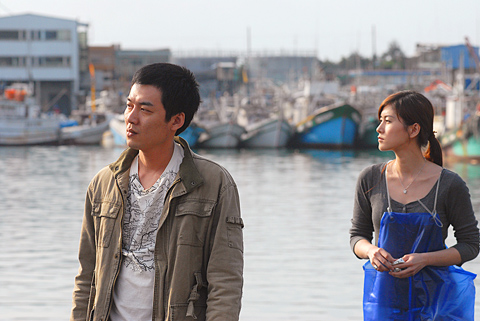Soul of a Demon (蝴蝶), celebrated director Chang Tso-chi's (張作驥) first film in five years, almost didn't make it to the big screen. Originally envisioned as a work of magic realism aided by CGI effects, the production came to a halt when the animation production company backed out of the project. After scraping together a new budget, Chang and his team re-shot the movie one year later. The result is a sober human drama about a tormented gangster who is unable to disengage from the cycle of violence and his troubled relationship with his father.
Set in Nanfangao (南方澳), a fishing port built by the Japanese, the film begins when Che (Tseng Yi-che) returns home from jail. Che took the rap for his younger brother, Ren (Cheng Yu-ren), who had stabbed to death the son of a local mob boss.
To reconnect with his semi-Aboriginal roots, Che visits his mother’s grave in Orchid Island (蘭嶼) with his ex-girlfriend Pei (Chen Pei-chun), who is mute from past emotional trauma.

PHOTO: COURTESY OF CHANG TSO CHI FILM STUDIO
Meanwhile, Ren returns from hiding in Japan with the brothers’ father, Chang (Michio Hayashida), whose departure from the family home led to his wife’s suicide. Old hatreds erupt, and violence rears its ugly head.
The title of the film comes from the Tao (達悟) word for butterfly. Tao tribal tradition holds that at the moment of death, a person’s soul leaves their body much in the same way as butterflies flutter towards the sky.
From images of butterfly wings shimmering on bamboo trees and the deserted amusement park where Che is abandoned by his father, to a glove puppet performance on the seashore, the film creates an atmospheric world in which the troubled protagonist is eventually consumed by his past and memories.

PHOTO: COURTESY OF CHANG TSO CHI FILM STUDIO
Though death, wickedness and human tragedy are motives in Chang’s work, the director’s sense of fatalism is taken to new heights in Soul of a Demon: men find no way to escape the vicious cycle of und erworld vendetta and women are either crippled, mute or dead. Chang’s Nanfangao is dismal and bleak, and suffocates the characters.
The fishing port is an ideal vehicle for Chang’s contemplative reflection on Taiwan’s history and the country’s hybrid cultural and political identities. By adding the role of Che’s grandfather, a photographer who came to Nanfangao with a Japanese construction team, to the story, Chang reveals the history of Nanfangao as one of the places where the first wave of Japanese soldiers and civil servants arrived in Taiwan. Che’s conflicts with his family, therefore, can be read as a metaphorical reference to Taiwan’s historical relationships with Japan and the nation’s Aborigines.
With the divine dancing Eight Generals (八家將) practitioners in Ah Chung (忠仔, 1996), the blind and gangsters in Darkness and Light (黑暗之光, 1999) and the deprived youth in The Best of Times (美麗時光, 2002), Chang excels in revealing the beauty and ugliness of life through the stories of social underdogs. In Soul of a Demon, the motifs are all there: gangsters, people with disabilities and a dysfunctional family. Yet the film is likely to be seen as one of Chang’s less successful pieces, since the story is oftentimes strays and becomes lost in the director’s auteurist exercise.

PHOTO: COURTESY OF CHANG TSO CHI FILM STUDIO
The film is, perhaps, like the director himself readily admits, a faithful reflection on the chaos of his life, frustrations and the passing of his father five years ago.

April 14 to April 20 In March 1947, Sising Katadrepan urged the government to drop the “high mountain people” (高山族) designation for Indigenous Taiwanese and refer to them as “Taiwan people” (台灣族). He considered the term derogatory, arguing that it made them sound like animals. The Taiwan Provincial Government agreed to stop using the term, stating that Indigenous Taiwanese suffered all sorts of discrimination and oppression under the Japanese and were forced to live in the mountains as outsiders to society. Now, under the new regime, they would be seen as equals, thus they should be henceforth

Last week, the the National Immigration Agency (NIA) told the legislature that more than 10,000 naturalized Taiwanese citizens from the People’s Republic of China (PRC) risked having their citizenship revoked if they failed to provide proof that they had renounced their Chinese household registration within the next three months. Renunciation is required under the Act Governing Relations Between the People of the Taiwan Area and the Mainland Area (臺灣地區與大陸地區人民關係條例), as amended in 2004, though it was only a legal requirement after 2000. Prior to that, it had been only an administrative requirement since the Nationality Act (國籍法) was established in

With over 80 works on display, this is Louise Bourgeois’ first solo show in Taiwan. Visitors are invited to traverse her world of love and hate, vengeance and acceptance, trauma and reconciliation. Dominating the entrance, the nine-foot-tall Crouching Spider (2003) greets visitors. The creature looms behind the glass facade, symbolic protector and gatekeeper to the intimate journey ahead. Bourgeois, best known for her giant spider sculptures, is one of the most influential artist of the twentieth century. Blending vulnerability and defiance through themes of sexuality, trauma and identity, her work reshaped the landscape of contemporary art with fearless honesty. “People are influenced by

Three big changes have transformed the landscape of Taiwan’s local patronage factions: Increasing Democratic Progressive Party (DPP) involvement, rising new factions and the Chinese Nationalist Party’s (KMT) significantly weakened control. GREEN FACTIONS It is said that “south of the Zhuoshui River (濁水溪), there is no blue-green divide,” meaning that from Yunlin County south there is no difference between KMT and DPP politicians. This is not always true, but there is more than a grain of truth to it. Traditionally, DPP factions are viewed as national entities, with their primary function to secure plum positions in the party and government. This is not unusual